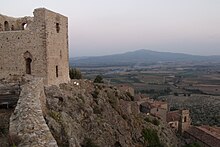Montemassi
| Montemassi | |||
|---|---|---|---|

|
|||
| Panorama of Montemassi | |||
| Country | Italy | ||
| region | Tuscany | ||
| province | Grosseto (GR) | ||
| local community | Roccastrada | ||
| Coordinates | 43 ° 0 ' N , 11 ° 4' E | ||
| height | 280 m slm | ||
| Residents | 188 (2011) | ||
| Telephone code | 0564 | CAP | 58020 |

Montemassi is a district ( fraction , Italian frazione ) of Roccastrada in the province of Grosseto , Tuscany region in Italy .
geography
The place is 8.7 km west of the capital Roccastrada, 26 km north of the provincial capital Grosseto , 87 km south of the regional capital Florence and 42 km southwest of Siena . The place is in the Maremma landscape and in the Colline Metallifere at 280 meters above sea level . Directly to the south the place borders on Ribolla . The place had 176 inhabitants in 2001.
history
The castle Castello di Montemassi was probably built around the year 1000 as a castle of the Aldobrandeschi with a Borgo (lower town) and an attached city wall . The place was first mentioned in 1076 in a deed of donation from Ildebrandino Aldobrandeschi, who bequeathed goods to the castle church. In the run-up to the Battle of Montaperti , the place was supported by Florence in 1259 and encouraged a rebellion against Siena. The first siege by Senese troops was interrupted by the difficult situation in the main town of Siena, where the troops had to rush to help. The second siege took place a year later after the Battle of Montaperti, this time successfully. The Senese gave the place in the first years of the 14th century to the Pannocchieschi family and the Cappucciani from Sticciano . In 1328 the place rose under Castruccio Castracani against Siena, who immediately sent their troops to Montemassi to besiege the place again. The painting Guidoriccio da Fogliano all'assedio di Montemassi (Guidoriccio da Fogliano during the siege of Montemassi) was created around this event . The Salimbeni family under Niccolò (also called Cocco ) and Cione di Sandro de 'Salimbeni from Siena took over the place in autumn 1374 against the will of the government in Siena, which led to further conflicts, which were resolved a year later through the mediation of Florence could become. The peace treaty provided for the castle to be passed on to Florence, which in turn was returned to Siena. Siena installed the Verdelli family from Montalcino as the new masters, who ruled until 1404. After another uprising by the lords of the castle, the castle was demolished by Siena in 1413 in order to protect the republic from further use against it.
After the defeat of the Senese Republic in 1555 against the Republic of Florence, the place (like Siena) also fell to the Duchy of Tuscany . The official act was signed on August 27, 1559. The Grand Duke of Tuscany, Ferdinando II. De 'Medici , made the place available to the Malaspina di Mulazzo as a feudal system on September 19, 1632 . They sold their rights to the fief together with Roccatederighi on April 7, 1770 to Giovanni di Domenico Cambiaso from Genoa . After the unification of Italy in 1861, the place became part of the municipality of Roccastrada.
Painting by Guidoriccio da Fogliano all'assedio di Montemassi
The place achieved greater fame through the fresco Guidoriccio da Fogliano all'assedio di Montemassi (Guidoriccio da Fogliano at the Siege of Montemassi) by Simone Martini in the Sala del Mappamondo of the Palazzo Pubblico in Siena. The castle on the left represents Montemassi, the castle in the middle probably Sassofortino (district of Roccastrada). The picture shows the condottiere Guidoriccio da Fogliano at the siege of Montemassi.
Attractions
- Chiesa di Sant'Andrea Apostolo , main church in the historic center, which was first mentioned in the 14th century. Contains the work Madonna col Bambino from 1490 , which is attributed to the environment of Matteo di Giovanni or Guidoccio Cozzarelli .
- Chiesa di Santa Maria delle Grazie , church from the 13th century. Contained Madonna col Bambino , which is now in the Chiesa di Sant'Andrea Apostolo .
- Palazzo del Capezzolo , 16th century palace
economy
From 1840 until the middle of the 20th century, mining played an important economic role in Montemassi.
literature
- Roberto Farinelli, Riccardo Francovich : Montemassi. In: Guida alla Maremma medievale. Itinerari di archeologia nella provincia di Grosseto, pp. 86–98, Nuova Immagine Editrice, Siena 2000, ISBN 88-7145-170-8 , online edition (PDF; 969 kB) of the University of Siena
- Giuseppe Guerrini / Amministrazione Provinciale di Grosseto: Torri e Castelli della provincia di Grosseto. Nuova Immagine Edizioni, Siena 1999, ISBN 88-7145-154-6 , p. 60.
- Silvia Guideri, Roberto Parenti: Archeologia a Montemassi: un castello fra storia e storia dell'arte. All'Insegna del Giglio, Florence 2000, ISBN 88-7814-193-3 , online edition of the University of Siena
- Luigi Pruneti: La Toscana dei misteri. Editrice Le Lettere, Florence 2004, ISBN 88-7166-852-9 , p. 157 ff.
- Emanuele Repetti: Dizionario Geografico Fisico Storico della Toscana. Online edition of the University of Siena
- Bruno Santi: Guida Storico-Artistica alla Maremma. Nuova Immagine Edizioni, Siena 1995, ISBN 88-7145-093-0 , p. 89 ff.
- Touring Club Italiano : Toscana , Milan 2003, ISBN 88-365-2767-1 , p. 859.
Web links
Individual evidence
- ↑ Istat and TCI
- ↑ Official website of the ISTAT ( Istituto Nazionale di Statistica ) on 2001 population figures in the province of Grosseto, accessed on June 6, 2012 (Italian)
- ^ Langton Douglas: A History of Siena. Betti Editrice, Siena 2000 (Org. London 1902), ISBN 88-86417-61-6 , p. 76.
- ↑ Alessandra Carniani: I Salimbeni. Quasi una signoria. Protagon Editori, Siena 1995, ISBN 88-8024-090-0 , pp. 250 ff., 263, 286.


